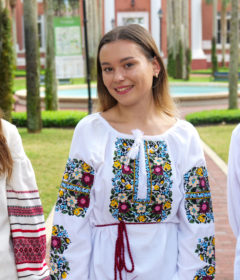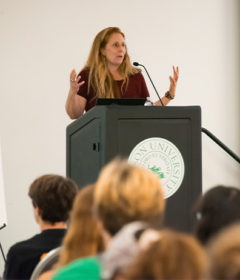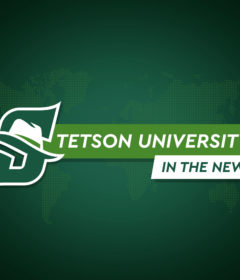Creating Paths to Citizenship
by Scott Morris
With United States voters divided over what to do about illegal immigration, the issue has become so contentious both President Barack Obama and Congress are loath to confront it, especially heading into the 2014 mid-term elections. Yet, the problem grows worse every day, a truth that was emphasized by tens of thousands of women and children from Honduras, Guatemala and other countries flooding the border to seek asylum.
T. Wayne Bailey, Ph.D., professor and founder of the Political Science Department at Stetson University, sees the current stalemate in Washington regarding illegal immigration in stark terms.
“By failing to address fundamental issues in policy, the problem becomes deeper and deeper,” Bailey says. “The number of illegals is around 14 million. That’s greater than the populations of some of our smaller states. The longer we delay taking action the worse things will get.”
A keen observer and enthusiast of politics for many years, Bailey has plenty to say about the culpability of politicians, but he’s also well aware that the current environment is so acrimonious it is dangerous for politicians to take a stand. As Florida’s junior senator, Marco Rubio, learned, when you step up with a plan special interest groups on both sides of the issue practice total warfare. The effect stifles legitimate debate, polarizes both sides, and makes political compromise and consensus unlikely.
“It’s a complicated, difficult matter, but one we can no longer ignore,” Bailey insists. “We must have comprehensive reform that takes security of the border and the laws of citizenship seriously, while at the same time provides a fair path to citizenship for some of those who are in this country illegally.” Bailey believes that after the next presidential election, there will be an opportunity.
“Hopefully the next president will have a 100-day honeymoon period to get a bi-partisan plan through Congress,” he says. “That’s what has to happen. We can’t do this with one piece of legislation at a time. The policy must be comprehensive.”
The key aspect of a comprehensive policy is that it addresses all the problematic issues of the illegal immigration debate. It will necessarily come to terms with thorny questions such as: Why should some people get citizenship for breaking the law? Why should the children of illegal immigrants suffer? It is impracticable — and in some cases for American business undesirable — to deport all illegal aliens, so what is a fair pathway to citizenship? What about cultural assimilation — don’t our democratic institutions require knowledge of America’s cultural foundations?
One of the biggest problems in reaching a consensus on those questions is that special-interest-group thinking has hijacked the debate. If you worry about cultural assimilation, according to those who would prevent debate simply by branding illegal immigration the new civil rights issue, you are a racist. If you believe there are ways to integrate illegal immigrants into American culture in a mutually beneficial way, you are a bleeding-heart with no respect for the rule of law. The loudest voices are the very voices that should be ignored. Cue Yeats’s line from “The Second Coming:” The best lack all conviction, while the worst/Are full of passionate intensity.
According to Bailey, there is another way of looking at the question of illegal immigration that is conspicuously absent from the national discussion. Ultimately, U.S. foreign policy is going to have to play a role. Simply put, America will have to deal with those forces that are pushing people to enter the U.S. illegally.
Paul J. Croce, Ph.D., professor of American studies at Stetson University, agrees this is a major blind spot. Why are people willing to risk their lives to enter the U.S.? The answer can be described in terms of push and pull factors, Croce points out. Push factors would be poverty, malfunctioning or non-functioning political systems, and war to name a few. Pull factors?
Blame the American Dream.
“For all of our very genuine problems, this country is, relatively speaking, a haven of security and opportunity,” says Croce. “Granted the opportunities are undercut by prejudice and the sheer difficulty of competitiveness, but there is a sense that you have a chance in America; so even stiff odds mean that the U.S. is not just a land of opportunity, but also a land of livelihood sweepstakes: get your ticket, migrate here, and maybe, just maybe…”
Both Bailey and Croce argue that immigrants have always been a vital part of keeping the American Dream energized. Immigrants often come to the U.S. with an appreciation for America that would leave most high school civics teachers breathless with admiration. But that is not to say the U.S. can accommodate an endless flow of immigrants. The push factors must become a part of the equation.
“Are we willing to address the impoverishment of citizens in poor nations and change policies that encourage dependency and debt?” Croce asks. “While globalizing economic trends and institutions provide many good things, including broader markets, increased employment and greater wealth, these good things often come with loss of local traditions and skills, subordination to outsiders, and dependency on fickle global markets — and those high negatives are pushing global migrants. Without such changes, pressures for immigration to the U.S. seem virtually inevitable.”
We can’t have our cake and eat it too. We can’t shut down our borders and retreat from an active role in helping other nations develop, because the extent to which we prosper while other nations continue to decline is the extent to which there will be enormous push factors for immigration.
“So we have a choice,” Croce argues. “We can devote more energy and resources into punishment of offenders, or we can direct some of that treasure into reshaping the structures that push people into these positions. I vote for prevention because it’s easier than cure — it is both cheaper and more just.”
Bailey believes Americans would do well to attend a Naturalization Ceremony such as the one he was a part of recently, hosted on Stetson University’s DeLand, Fla., campus for more than a hundred new citizens.
“They treasure becoming U.S. citizens,” Bailey says. “They take classes in America’s history, laws, political system and the duties of citizenship. They learn English. They’re proud to pass those tests.”
Another interesting way to illuminate the debate is to take a look at the oath prospective citizens are required to take. It is difficult to read the oath and then take seriously the thinking which would simply declare that illegal immigrants have a civil right to U.S. citizenship, or to embrace the other extreme which would dictate that any pathway to citizenship amounts to a power grab for illegal immigrants who are only interested in cashing in on the American system.
The oath makes clear that both extremes are guilty of taking the blessing of U.S. citizenship too lightly:
“I hereby declare, on oath, that I absolutely and entirely renounce and abjure all allegiance and fidelity to any foreign prince, potentate, state, or sovereignty, of whom or which I have heretofore been a subject or citizen; that I will support and defend the Constitution and laws of the United States of America against all enemies, foreign and domestic; that I will bear true faith and allegiance to the same; that I will bear arms on behalf of the United States when required by the law; that I will perform noncombatant service in the Armed Forces of the United States when required by the law; that I will perform work of national importance under civilian direction when required by the law; and that I take this obligation freely, without any mental reservation or purpose of evasion; so help me God.”
Scott Morris is a freelance writer in Central Florida.



